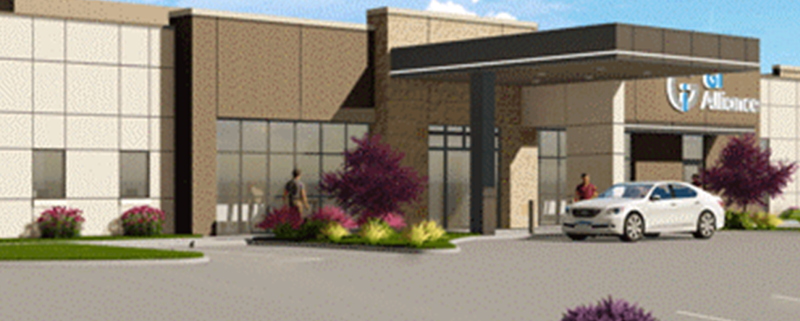The healthcare sector faces more challenges related to design and construction than any time in recent memory.
COVID-19 brought sweeping challenges to most healthcare systems and providers. However, in many ways, COVID-19 highlighted structural flaws that existed well before the pandemic Staff burnout and labor shortages, a fragile supply chain, and increasingly difficult payor models were all in play in 2019, but the pandemic negatively impacted each of these systems. We now find the industry in a precarious position.
In 2022, overall operating margins for many U.S. hospitals were negative, according to management consulting firm Kaufman Hall, which characterized last year as “one of the worst financial years for hospitals.” The near future is likely to bring further challenges, not the least of which is the end of the 20 percent Medicare premium for COVID-19 admissions in May 2023.
Add to the mix: 54 percent of the nursing and physician workforce is experiencing burnout, per a May 2022 report “Addressing Health Worker Burnout” from the United States Department of Health and Human Services (HHS). Additionally, 45 to 60 percent of medical students and residents report the same.
This reality poses another financial challenge for organizations that will be forced to invest more in salaries, benefits, and anti-burnout strategies to attract and retain top talent. Simultaneously, the competitive landscape is changing rapidly. Healthcare systems have long relied on a delicate balance of inpatient diagnostic and procedure care plus hospital outpatient department (HOPD) revenues to make up for acute care operating losses.
Now these systems find themselves competing against a widening field of players. These new entrants to direct patient care include Amazon, CVS, Optum, and even insurance companies that are acquiring direct-care entities aiming to deliver services conveniently and at lower cost. They’re also recruiting clinical providers with attractive compensation and work-life balance packages that 24/7 hospitals can seldom match.
These numerous pressures add new, significant challenges to one of the most important levers in the business of healthcare: capital expenditures spending (also, known as capex). Fortunately, this unprecedented environment also presents enticing opportunities within capital planning, design, and construction.
Four healthcare design and construction trends are providing opportunities for healthcare leaders to pivot their strategies to optimize capex spending. These changes can allow systems to increase patient engagement, restore patient revenue, and grow the top and bottom lines to improve return on investment.
1. Hospital Project “Sputter”
While architecture/engineering/construction (A/E/C) firms are far from sounding the alarm, billings and project starts are showing signs of softening. A December 2022 AIA report, “Architecture firm billings end the year on a soft note,” shows roughly nearly 40 percent of firms saw an increase in project stalls, while 28 percent indicated project holds to be a “somewhat serious” issue.
False starts and holds on healthcare projects are a direct result of the myriad conditions organizations face. They also reflect the imperative upon most systems to reduce cost of care in a meaningful way. While there will always be a need for plant maintenance projects, ground-up and greenfield expenditures must either expand market share, reduce cost of care, or, increasingly, achieve both.
While financial stability has always been a major determinant of new capital expenditures, healthcare systems must now contend with broader questions:
• Is the project diverting patients to a less costly site of care?
• Would a digital solution solve our problem instead of new real estate?
• Can we partner with another player (retail, digital, payor) to affect the same outcome in a different way? The AHA has creatively referred to these partnerships as “coopetition,” in which providers increasingly leverage large industry players to lower cost of care.
As the field of healthcare players widens, systems are faced with more complex options. The all-too-common result is capex projects that sputter in and out of existence. This is not likely to wane soon—the fundamental challenges facing healthcare have been years in the making and will take years to resolve.
Healthcare leaders should look to their A/E/C consultant partners to engage in nimble planning that breaks the mold of traditional linear processes and is more responsive to the fluid nature of today’s environment.
This requires partners to consider how they can pivot their offerings to meet market and client needs. Decision-makers should ensure partners can successfully address questions such as:
• How might the traditional multi-month master planning and pricing exercise be consolidated into a 5-day or 30-day sprint that answers the same fundamental questions but avoids a drawn-out analysis of an uncertain concept?
• Can a construction firm leverage its awareness of the supply chain, lead times, site analysis, escalation, and trades availability to co-author a more robust and actionable feasibility analysis?
• Could individual providers across the A/E/C landscape come together with advisory solutions that are predictable, quick, and attractive to C-suite healthcare executives who are desperate for support but hesitant to invest in conceptual ideas?
2. Tech-Centric Healthcare
Digital investment still hinges on uncertain industry regulations and consumer uptake. But one thing is sure: the pandemic reinforced the concept that healthcare organizations need to adapt their physical infrastructures to support the demands of technology-enabled omnichannel patient experience (PX) systems, clinical care, and digital tools to provide education and enhanced healthcare choices.
As buildings become smarter, the way healthcare leaders and service providers integrate teams, processes, and systems during planning, design, and construction also needs to evolve. Organizations need their A/E/C partners to work closely with all stakeholders to gain a holistic view of this approach and all relevant financial aspects.
These stakeholders include the chief information officer (CIO), PX leaders, designers, trade partners, technology vendors, and end-users. It’s important they are engaged early in the project lifecycle to make projects more cost-effective and ensure all components work as expected at turnover/activation.
For example, DPR Construction recently completed a project at Inova Loudoun Hospital in Virginia to coordinate the organization’s clinical and PX systems during construction. This included integrating more than 30 systems (e.g., lighting to help regulate the rhythm of day and night, patient and guest entertainment technology), plus low-voltage systems designed to allow future tech adaptations.
All the systems were thoroughly planned, allowing for seamless start-up and operations. A holistic approach like this accounts for a critical issue: the total cost of the project. It’s vital to design and build to incorporate all critical technology and systems into projects early in the process. This can reduce total cost by mitigating the expense of adding tech when a project is nearly finished or complete.
3. Flexibility In Where Healthcare Is Delivered
The pandemic’s long-term impact on site-of-service shifts is unclear (some care was diverted from hospitals, but a great deal of care was simply delayed). But it did provide an experiment in the uptake and viability of virtual health. What began as a temporary solution has become a surge of virtual health solutions (connected services, devices, and support) that show promise for temporal and chronic disease management.
Managing disease through a series of episodic hospital visits is not financially viable for patients, providers, or payers. And as reimbursement continues to ratchet down, providers now face an imperative to reduce cost of care or risk financial insolvency.
A high priority for many providers is keeping patients out of physical sites of care altogether. However, an equally high priority is shifting to sites where care can be delivered at a lower cost than either a hospital or hospital outpatient department (HOPD).
A recent McKinsey article shows that ambulatory care now makes up roughly 30 percent of total provider revenues. Future growth sources include urgent care, ambulatory surgery centers, and outpatient behavioral health facilities.
Healthcare leaders should identify A/E/C partners who can leverage viable ambulatory strategies by bringing new ways of thinking and delivering these capital projects. Considerations include:
• During concept and program development, partners must address the impact of virtual healthcare. Whereas telehealth might have had near-zero impact on volumes five years ago, virtual health options that reduce the demand for real estate continue to expand and diversify.
• The typical 50-year lifespan of health facilities is no longer an assumption for ambulatory settings. Partners should be prepared to develop solutions with short payback periods and focused objectives that may radically change in five years.
• As providers look to capture market share based on convenience and access, retrofits into non-health facilities will proliferate. Healthcare leaders need A/E/C partners to help them envision creative adaptations into challenging core-and-shell scenarios.
4. Predictive And Prefabricated Building Solutions
One traditional upside of prefabrication has been speed to market above all else. While prefabrication solutions sometimes have a higher price tag, common logic has held that cutting schedule is more valuable than a premium first cost for assemblies due to the ability to see patients sooner and generate additional revenue.
As healthcare leaders seek to lower costs while accelerating speed to market, they are turning over every stone—seeking real estate solutions that support Lean operational models of care, reinforce enterprise branding, and offer lower and predictable lifecycle costs.
Leaders in the A/E/C industry are enabling this strategy by providing advance prefabrication elements that are advantageous for a wider selection of building typologies and are more likely to benefit from economies of scale.
Another trend gaining traction moves beyond component-based prefabrication and into a realm of predictive real estate solutions. Ranging from micro to macro, these concepts cover prefab elements that can support larger and more varied care distribution systems.
This includes the use of prefab elements that can be deployed in repeatable clinical and support spaces. Individual room templates can also be prefabricated to provide consistent care environments across multiple sites. This approach can optimize capex investments and speed-to-market for many healthcare systems, while providing a better patient experience.
Moreover, predictive solutions also involve the use of prototypes designed to meet both current and future needs. At the departmental level, prototypes should be developed for repeatable use, but also remain flexible enough to be hosted within multiple core-and-shell scenarios.
On a larger scale, entire building prototypes can be designed to offer an agile chassis to host a variety of care models in order to successfully align with the long-term goals of the organization.
In all cases, delivery partners should be prepared to co-define the “true north” for predictive solutions alongside providers. In other words, before exploring what should be standardized or prefabricated, teams must define the problems to solve.
Because predictive solutions are not a one-size-fits-all question, healthcare leaders need partners that assess the feasibility and viability of solutions within their unique organizational context. Finally, adoption of prefab solutions requires early understanding of cost, clinical, and maintenance ramifications. Healthcare providers should lean on partners who can address all these dimensions so they can make informed decisions.
Future Healthcare Capital Development
When considering the state of today’s healthcare environment, a certain axiom comes to mind: “May you live in interesting times.” For most healthcare leaders, this is an understatement, as financial pressures will be a primary factor for the foreseeable future.
That doesn’t mean the future has to be bleak. When it comes to capital development, savvy decision-makers are forging stronger bonds with their A/E/C partners to devise innovative solutions to meet these challenges head on.
At the end of the day, healthcare organizations that embrace this opportunity to evolve will be the ones that succeed over the long term.
Source: healthcare design




